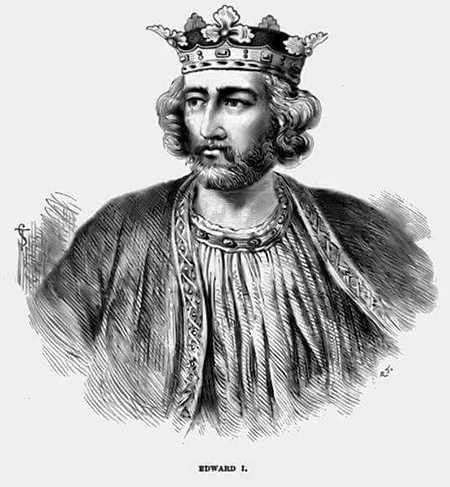



King Edward I – Quick Stats




Born: June 17, 1239
Edward I: The Warrior King Who Shaped England and Conquered Wales
King Edward I of England (1239–1307), known as "Longshanks" due to his great height and "Hammer of the Scots" for his campaigns against Scotland, was one of England's most formidable medieval kings. His reign was marked by military conquests, legal reforms, and the strengthening of royal authority.
Early Life and Ascension to the Throne
Edward was born on June 17, 1239, at the Palace of Westminster, the eldest son of King Henry III and Eleanor of Provence. From an early age, he was trained in warfare and governance, preparing for the challenges that lay ahead. He played a crucial role in suppressing the Second Barons' War, during which he fought alongside his father against rebellious nobles led by Simon de Montfort.
Edward was born on June 17, 1239, at the Palace of Westminster, the eldest son of King Henry III and Eleanor of Provence. From an early age, he was trained in warfare and governance, preparing for the challenges that lay ahead. He played a crucial role in suppressing the Second Barons' War, during which he fought alongside his father against rebellious nobles led by Simon de Montfort.
Edward distinguished himself at the Battle of Evesham in 1265, where he led the royalist forces to a decisive victory, restoring his father's authority. Following this success, he continued to consolidate his power, gaining the trust and loyalty of England's nobility.
He enacted several key laws, including:
The Statute of Westminster (1275, 1285): Reformed property laws, established legal precedents, and reinforced royal justice.
The Statute of Mortmain (1279): Restricted the transfer of land to the Church without royal permission, preventing feudal lords from bypassing the king’s authority.
The Statute of Quo Warranto (1290): Required landowners to prove their legal right to hold lands, reducing feudal power.
The Expulsion of the Jews (1290): Edward issued an edict expelling all Jews from England, a decree that remained in effect for over 350 years.
The Statute of Westminster (1275, 1285): Reformed property laws, established legal precedents, and reinforced royal justice.
The Statute of Mortmain (1279): Restricted the transfer of land to the Church without royal permission, preventing feudal lords from bypassing the king’s authority.
The Statute of Quo Warranto (1290): Required landowners to prove their legal right to hold lands, reducing feudal power.
The Expulsion of the Jews (1290): Edward issued an edict expelling all Jews from England, a decree that remained in effect for over 350 years.
In 1282, a Welsh rebellion erupted, leading to a second and more brutal campaign by Edward. Llywelyn was killed in battle, and Wales was fully annexed into England by 1283. To secure his conquest, Edward constructed a series of imposing castles, such as Conwy, Harlech, and Caernarfon, establishing English dominance over Wales.
Died: July 7, 1307
Mother: Eleanor of Provence
Father: King Henry III of England
Wives:
Children:
Eleanor of Castile (m. 1254–1290)
Margaret of France (m. 1299–1307)
Margaret of England
Joan of Acre
Edward II
Successor: Edward II
Predecessor: King Henry III
Edward was a skilled warrior, a determined ruler, and a monarch whose policies had a lasting impact on England and its neighboring territories. His rule also laid the foundation for the further expansion and consolidation of the English monarchy, influencing governance for generations to come.
In 1270, he embarked on the Ninth Crusade, traveling to the Holy Land in an attempt to aid the Christian cause. Although the crusade was ultimately unsuccessful in reclaiming lost territory, Edward gained valuable military experience and further solidified his reputation as a warrior.
These reforms helped centralize royal authority, weaken feudal autonomy, and create a more structured legal system in England. Edward’s emphasis on law and order ensured that England had a more effective government, which would be crucial in maintaining stability in the following centuries.
Death and Legacy
Edward I died on July 7, 1307, at Burgh by Sands of Dysentery while preparing another campaign against Scotland. He was succeeded by his son, Edward II, whose reign would be marked by instability and conflict. Edward I had reportedly requested that his bones be carried into battle against the Scots after his death, signifying his lifelong commitment to conquering Scotland.
Edward I died on July 7, 1307, at Burgh by Sands of Dysentery while preparing another campaign against Scotland. He was succeeded by his son, Edward II, whose reign would be marked by instability and conflict. Edward I had reportedly requested that his bones be carried into battle against the Scots after his death, signifying his lifelong commitment to conquering Scotland.
Edward I’s legacy is a complex one. He was a strong and determined ruler who expanded English territories and reinforced royal power. His legal reforms had a lasting impact on English governance, and his military campaigns shaped the histories of both Wales and Scotland. However, his harsh policies, particularly against the Scots and the expulsion of Jews from England in 1290, have also cast a shadow over his rule.
Despite these controversies, Edward I remains one of the most influential medieval English kings, remembered for his military prowess, administrative innovations, and the transformation of England into a more centralized and powerful monarchy. His ambitious projects, including the development of Parliament and the construction of imposing castles, demonstrated his vision for a stronger England. Edward’s legacy as both a warrior and a legislator ensured that his influence would be felt long after his death, shaping the course of English history for centuries.
After Henry III’s death in 1272, Edward ascended to the throne while still returning from the crusade. He was formally crowned in 1274 upon his return to England, and his reign would go on to be defined by military ambition, legislative reform, and administrative restructuring.
Conquest of Wales
One of Edward’s first major military endeavors was the conquest of Wales. In 1277, he launched a campaign against Llywelyn ap Gruffudd, the Prince of Wales, after Llywelyn refused to submit to English authority. Edward's forces overran Welsh territories, forcing Llywelyn to accept humiliating terms.
One of Edward’s first major military endeavors was the conquest of Wales. In 1277, he launched a campaign against Llywelyn ap Gruffudd, the Prince of Wales, after Llywelyn refused to submit to English authority. Edward's forces overran Welsh territories, forcing Llywelyn to accept humiliating terms.
These castles not only served military purposes but also acted as administrative centers for English rule. Additionally, Edward implemented administrative changes that brought Welsh lands under English law and appointed English officials to govern the region. In 1301, he named his son Edward, the future Edward II, the first Prince of Wales, establishing a tradition that continues to this day.
Wars with Scotland
Edward’s ambition extended northward, leading to prolonged conflicts with Scotland. In 1290, after the death of Queen Margaret of Scotland, a succession crisis known as the "Great Cause" arose. Edward was invited to mediate but instead used the opportunity to assert English overlordship over Scotland. He selected John Balliol as king, expecting him to be a puppet ruler, but Balliol resisted Edward’s authority.
Edward’s ambition extended northward, leading to prolonged conflicts with Scotland. In 1290, after the death of Queen Margaret of Scotland, a succession crisis known as the "Great Cause" arose. Edward was invited to mediate but instead used the opportunity to assert English overlordship over Scotland. He selected John Balliol as king, expecting him to be a puppet ruler, but Balliol resisted Edward’s authority.
In 1296, Edward invaded Scotland, defeating Balliol and taking control of the country. However, resistance continued under leaders like William Wallace and later Robert the Bruce. Wallace’s victory at the Battle of Stirling Bridge in 1297 was a major setback for Edward, but the English king responded with overwhelming force, crushing Wallace’s forces at the Battle of Falkirk in 1298. Wallace was eventually captured and executed in 1305, but the Scottish resistance persisted.
Robert the Bruce emerged as the leader of the Scottish resistance in 1306, proclaiming himself King of Scots. Edward, determined to crush the rebellion, embarked on another campaign to subdue Scotland. However, he died in 1307 while marching north to confront Robert the Bruce, leaving the conflict unresolved for his successor.
Legal and Administrative Reforms
Edward was not only a warrior but also a reformer. He introduced significant legal and governmental changes that strengthened the English monarchy. His reign saw the development of Parliament as a more permanent institution, expanding the role of commoners in government.
Edward was not only a warrior but also a reformer. He introduced significant legal and governmental changes that strengthened the English monarchy. His reign saw the development of Parliament as a more permanent institution, expanding the role of commoners in government.
Statue of Edward I at Burgh by Sands
Elizabeth of Rhuddlan




